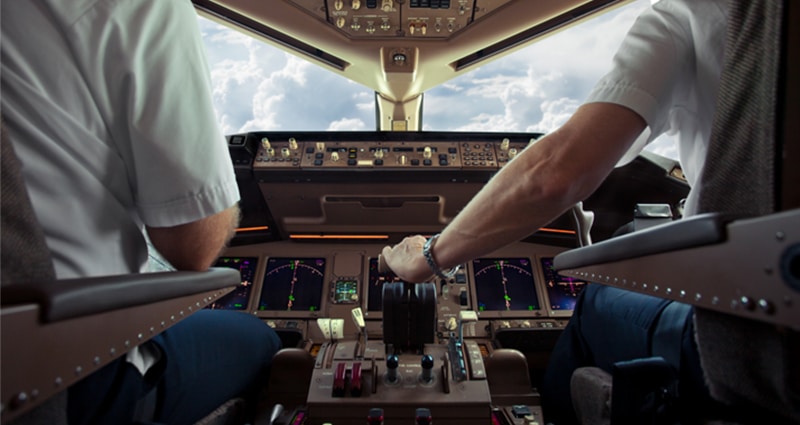Decompression Illness Following Explosive Cabin Depressurization

Decompression illness (DCI) is not just a scuba diving phenomenon. It can also be seen in aviation following a high‐altitude cabin depressurization. DCI occurs when there is a sudden lowering of ambient pressure, which allows nitrogen gas to come out of tissues too fast and form nitrogen gas bubbles. These bubbles tend to go to the large joints, especially the knees, hips, shoulders and elbows, sparing the small joints of the body.
The pain in these joints can be so severe that it causes the person to bend over, hence the term “the bends.” Worse is the possibility that these bubbles can also go to the spinal cord or brain, resulting in very serious neurological injury, even spinal cord paralysis.
Responding to Rapid Depressurization
At a cruise altitude of 40,000 feet, the risk for DCI is very serious following a rapid decompression. Most cabin altitudes during routine flight are approximately 5,000 to 8,000 feet. So, imagine being exposed to a rapid decompression where you ascend from 8,000 feet to an altitude that is 10,000 feet higher than Mt. Everest within minutes or even seconds!
During the emergency descent that follows a rapid depressurization, everyone onboard should already have an oxygen mask on, but it is possible that some people may begin to experience symptoms of DCI. Anyone who is symptomatic during the descent should remain on 100 percent oxygen and first responders at the airport should be notified. The individual should not remove the mask at any time and should remain as still as possible until paramedics arrive. Movement in general will worsen the condition and result in increased pain.
Upon landing, the individual should be transported immediately to the nearest hospital for medical care. If the symptoms persist, the person will need a hyperbaric chamber treatment no different than what scuba divers receive. Anyone complaining of weakness or numbness of the legs or arms may be facing impending severe neurological damage and should receive immediate medical care.
Medical Assessment is Critical
With rapid decompressions it is common for people to minimize their symptoms and want to go home quickly, having been frightened by the emergency. It is crucial that these people are assessed by paramedics before being allowed to leave as DCI can develop slowly develop over 24 hours. It is also essential that everyone onboard be given instructions on what to look for over the following 24‐hour period and told to report any symptoms they experience to their doctor or seek emergency treatment if appropriate. DCI can be insidious, and those at risk must remain vigilant for the next few days.
Rapid Decompression and Legal Liability
From a liability perspective, encouraging people involved in an incident to follow these recommendations can help protect the operator from a potential lawsuit. Documenting the fact that a post‐landing medical assessment with recommendations was performed, even for those without symptoms, further protects the operator.
Scuba Diving and DCI
Another time when DCI can be an issue is in the case of flying after scuba diving. In general, scuba divers should wait 24 hours before flying. This is due to the fact that excessive nitrogen gas that has accumulated while diving can take that long to equalize to ambient pressure. Exposing oneself to a cabin altitude of 8,000 feet soon after scuba diving dramatically increases the risk of developing DCI. If anyone onboard develops symptoms of DCI during the flight, this must be considered a medical emergency no different than that described above and handled in the same manner.
In summary, it is worthwhile for flight crews to review the basic symptoms of DCI periodically so they can better identify and manage passengers and crew during and after a high‐altitude rapid decompression or when someone flies too soon after scuba diving.

SAMI is the prime research institute regarding the phenomena of Slow Onset Hypoxia. SAMI’s decades of research have improved the way aviators around the world prepare themselves for oxygen contingencies. The patented DeSat Training program is the closest possible re-creation of the dynamic and task saturated environment a pilot will face during a pressurization event. This includes a medical understanding of hypoxia, FAA standard mask donning procedures, ATC communication, crew coordination, and post event training—all while operating at true altitudes and utilizing oxygen reserves.
http://www.SAMI-AeroMedical.com
© 2025 Southern AeroMedical Institute. All Rights Reserved.
Next ArticleRelated Posts

Emerging Security Threats in Business Aviation: Activism and Down-Route Risks
Security incidents affecting business aviation do not need to involve violence to have an operational impact. A protest delaying crew movements, blocking access to a hangar or resulting in an unauthorized photograph of a sensitive client can all trigger reputational, financial or compliance concerns for operators.

Little Things Matter: The Lost Key of the Titanic
Ultimately, the story of the Titanic’s lost key is a call to action for aviation professionals. It underscores the need for unwavering attention to detail, robust systems to catch human error and a culture that prioritizes safety over haste.

